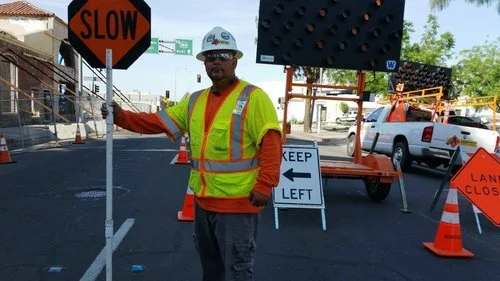High-Speed Rail Project
California High-Speed Rail Authority
What does it fund?
Development of California’s high-speed rail system, the first high-speed rail in the nation that will connect the megaregions of the state. When complete, it will run from San Francisco to the Los Angeles basin in under three hours at speeds capable of over 200 miles per hour, providing a clean alternative to driving or flying. Funded in part by California Climate Investments, the project is contributing to economic development and a cleaner environment, supporting jobs, and preserving agricultural and protected lands.
In operation, the significant capacity available to accommodate modal shift from driving and intrastate flights provides California with a unique transportation tool in its approach to a low carbon future. Estimated cumulative greenhouse gas (GHG) Well-to-Wheels emissions avoided from the California High-Speed Rail project is up to 142.6 million metric tons of carbon dioxide equivalents (MTCO2e) over its first 50 years of operating life, as detailed in the Table 4.0 of the 2024 California High-Speed Rail Sustainability Report.
The California High-Speed Rail Authority (Authority) has committed to and is delivering the greenest infrastructure project in the nation, both in construction and operations. The program received national recognition for its sustainability efforts when it received the Envision Platinum rating from the Institute for Sustainable Infrastructure. It is the highest-level award from the institute and the first time a program of this geographic size and complexity has earned such an honor. In keeping with its focus on advancing clean construction, the Authority requires contractors to use zero-emission vehicles for their project fleets in all future construction contracts.
The Authority has also taken several steps to help offset the emissions from the rail’s construction, as detailed in the 2024 California High-Speed Rail Sustainability Report:
Planted more than 7,100 urban trees since 2018. Urban and rural tree plantings combined are expected to sequester 143,000 MTCO2e over the trees’ life cycles
Sequestered or avoided approximately 348,700 MTCO2e through restoration of more than 4,400 acres of degraded lands, including 151 acres of wetlands, and protection of more than 3,190 acres of agricultural land since January 2016
Recycled more than 95 percent (306,159 tons) of all waste to date and sent less than 5 percent (16,581 tons) to landfills, avoiding more than 128,000 MTCO2e over the entire construction time frame.
How does this program provide benefits to priority populations?
As of December 2024, the Authority has commissioned work from 893 small businesses, including 309 Certified Disadvantaged Business Enterprises, ensuring small businesses play a significant role in the program. Importantly, 155 of the small businesses working on the high-speed rail system are in disadvantaged communities, as detailed on the Authority’s Small Business Program webpage.
To date, the project has created more than 14,900 construction jobs, with more than 70 percent of these jobs filled by residents from disadvantaged communities, across 119 miles of high-speed rail construction, as detailed in the Authority’s 2024 Business Plan and on the Authority’s website.
From July 2006 through June 2024, the project has invested approximately $13.0 billion in planning and construction for the nation’s first high-speed rail system. The Authority estimates that, during FY 2023-24, 71% of total project expenditures, including GGRF and other sources, occurred in disadvantaged community census tracts. To date, the project has resulted in payments exceeding $1.84 billion to certified Small Businesses, Disadvantaged Business Enterprises and Disabled Veteran Business Enterprises in California for work on the high-speed rail program. These estimates were obtained using a different methodology than other California Climate Investments programs. For more information on the methodology, see the Economic Impact of California High-Speed Rail 2025 report.
This investment in the California economy has supported direct, indirect, and induced jobs, over half of which are located in the Central Valley. These economic impacts have already taken place and do not consider the many future benefits once operations commence and the program delivers greater accessibility and station-area connectivity, reduced highway congestion, and travel time savings.
Additional Background:
The High-Speed Rail Community Benefits Agreement (CBA) encourages a 30 percent small business participation goal and ensures that 30 percent of all project work hours are performed by National Targeted Workers, with at least 10 percent of those work hours be performed by Disadvantaged Workers. Targeted Workers include individuals that reside in low-income ZIP codes. A Disadvantaged Worker is a Targeted Worker with additional barriers to employment.
The CBA definitions of Targeted Worker and Disadvantaged Worker are not currently aligned with the designations of priority populations for the purposes of meeting the investment minimums in SB 535 or AB 1550. For this reason, these employment benefits are not currently accounted towards meeting investment minimums for benefits to priority populations, despite providing a direct and assured benefit to those targeted employees.
Who is eligible for funds?
The California High-Speed Rail Authority contracts with hundreds of businesses throughout the state.
Funding Timeline
Please check the High-Speed Rail website for the latest contracting opportunities.
Project Profiles
Read stories of projects funded by this program.
Cumulative Statistics
As of November 30, 2023
$5.9 billion appropriated by the Legislature
$3.4 billion in expenditures
2022 Achievements
Reporting period:
Dec 1, 2021 – Nov 30, 2022
$1.3 billion in expenditures
By statute, the High-Speed Rail project is appropriated 25 percent of the proceeds of each quarterly auction. The Authority does not select or award funds, as all appropriated funds are used for the High-Speed Rail project.








